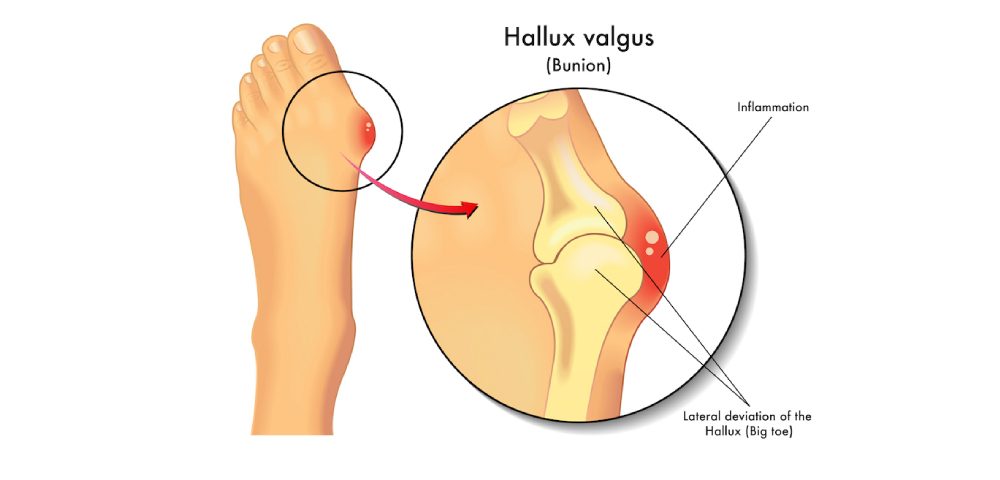- Have any questions?
- +91-9811443717
- [email protected]
10 things you need to know about bunions

5 ways to ease bunion pain without surgery
April 19, 2021
5 Things You Might Not Know about Flatfeet
May 18, 202110 things you need to know about bunions

A significant bump on the base of the big toe is a sign of a critical foot problem known as Bunion or Hallux Valgus. This problem can lead to structural deformity of the foot and requires special care from a medical expert for the cure or may lead to a complex condition that is difficult to cure. There are many facts related to bunions that everyone must know to maintain their foot health.
- Women are 10X more prone to bunions
It may sound shocking, but it is true. Women are ten times more prone to this foot problem, and the prime reason is the type of footwear. They prefer fancy footwear and are obsessed with heels as the aesthetic design takes priority over the function. Tight shoes & heels can lead to many foot problems, including bunions.
- Genes increase the risk
It is observed that people who have a family history of bunions are at a high risk of developing congenital or juvenile hallux valgus. It occurs due to genes, then a clear pattern of inheritance is observed in the occurrence of this problem.
- Many patients are unaware that they are suffering from bunions
Sometimes mild bunions are not painful, and their size may not be noticeable. You may not notice, but your joint will gradually deviate. So it is necessary to carefully look for bunions and get a periodic check-up from medical experts.
- Surgery is not necessary for the treatment of bunions with minimal symptoms
Yes, you can cure bunions without a surgical approach, and your doctor may recommend bunion pads, toe spacers, and bunion splints based upon the symptoms. These external devices may temporarily reduce the pain. Apart from that, some exercises for big toe and calf stretches can also help in reducing the pressure from the bunion and hence alleviate the pain. This approach however can’t treat the joint deformity.
- Surgery can help in getting rid of bunions
Bunions can affect the big toe as well as other toes, and in an advanced state, it is not easy to treat this problem. The surgical procedure can help in the realignment of the toes and treat the problem from the root. With a rehab plan, one can even strengthen their toes and come back with more force and confidence.
- Insoles are helpful in bunions
People with flat feet are more prone to have bunion deformity. One can try customized medial arch support to ensure that the foot is appropriately placed and aligned to prevent the bunion from getting worse. Similarly, an insole with a metatarsal pad may be helpful in reducing the symptoms arising from the lesser toes in patients with the bunion. There are many other orthotics that can help in customizing your footwear as per your condition.
- Footwear can be your trump player
Your right pair of shoes can play a crucial role in keeping up your foot health. Your foot is already suffering from a bunion, and your ill-fit shoe will lead to malalignment and derange the foot mechanics further. It will put more pressure on your foot and can increase the rate of worsening of the deformity. So as per the foot structure and comfort, one needs to wear the shoes. A shoe with a wider toe box is generally recommended for people suffering from bunions.
- Muscle spasms, corns, and calluses are not a good sign
Muscle spasm is a twitch in the muscle that occurs due to intense pressure. Corns and calluses develop due to sweat or tight shoes and usually affect toes. So it is essential to get medical advice as soon as you observe such problems.
- It’s never too late for treatment
Sometimes the patient may feel hopeless due to pain. Irrespective of the extent of the disease, there is a cure that can resolve most of the problems. In severe conditions, one needs to undergo surgery followed by rehab for complete recovery.
- Work on your foot strength today for a pain-free tomorrow
Your balance while walking will be affected due to bunions, and it is necessary to perform some foot exercises like pointing and flexing with the help of a ball to alleviate pain and improve the condition. Moreover, your foot exercises will help to make your muscles stronger and prevent worsening of the problem.
These were some facts that you must know about a bunion. Also, don’t neglect any medical advice. If you’re looking for a personal consultation, then you can consult Dr. Anuj Chawla. He is an experienced foot and ankle specialist in Gurgaon and even offers online consultation all over the country. He has helped many people in foot pain treatment via surgical and non-surgical approaches.

